Cork substrate for a laminate: the advantages of using cork and the specifics of its laying
Laying the laminate floor is inextricably linked with the preliminary flooring of the substrate. In the absence of this mandatory component, manufacturers of flooring generally do not consider consumer complaints in the event of premature wear of the material. To prepare the draft basis for the construction of the floor from the laminated panels, many versions of the synthetic and natural “lining” have been released, each of which has both positive qualities and disadvantages. Among them, a cork underlay under the laminate, which has specific properties and requires compliance with special laying rules.
Content
Why do we need a substrate?
A substrate is an indispensable component of a multilayer construction, ending with a final coating of laminated boards, because it:
- optimizes the thermotechnical properties of the floor;
- “Smooths”, but does not even out, minor flaws of the rough surface, the elimination of which is impractical to carry out by the next filling of the screed;
- prevents contamination of the castle system of the laminate with dust emitted by the upper layer of freshly poured concrete base during operation;
- It is a cut-off element necessary for the installation of flooring in a floating manner;
- plays the role of a waterproofing barrier that reduces the effect of moisture on the unprotected back of laminated dies;
- promotes uniform distribution of mechanical load;
- minimizes the noise effects that occur when walking on a floating floor and when objects fall.
Most manufacturers of laminate floors are manufacturing substrates compatible with their products. True, this does not mean that laminate flooring can only be made on a substrate with an equivalent brand. In the assortment line of segment leaders, such as the Swedish company TARKETT or the German company WITEX, there are varieties with a substrate attached to the panels. However, this is rare, and not cheap.
Note. Manufacturers of laminate floors recommend the best options for the substrate for their product, their advice is the main guideline for the proper selection of material.
In the predominant number of cases, an independent stacker has to select and purchase a substrate independently. Often, home craftsmen rely on economic aspects, although they regard the savings in different ways. For some, it is expressed in low cost, for others in long-term and reliability. Therefore, despite the impressive prices, a considerable part of consumer preferences is given to the technical traffic jam.
Operational Benefits of Cork Substrate
In connection with the budget cost of the laminate, builders consider the use of cork substrate as an irrational enterprise. Say, the price of 1 m² of floor then increases by 1.5–2 times, and even the coverage will last much less than the “lining” for it. Recall that we are building a floor for ourselves. We will take care of our health, because the layer will not emit toxins and accumulate allergens.Do not forget that no one forbids us to lay a fresh laminate or a noble piece parquet on top of a well-preserved technical jam.
In addition to long-term operation and environmental advantages of the layer created from natural raw materials, the following are convinced of the benefits of acquiring cork:
- ease of cutting, minimum labor during installation;
- perfect shape retention in all directions;
- the absence of cracks, crumbled flaws, dents, swollen bulges that arise from the improper use of other materials from organic matter;
- resistance to fire and subsequent spread of fire;
- antistatic properties;
- lightness due to which the total mass of the floor structure increases slightly;
- high porosity, giving the material optimal insulating qualities.
The cork treated with antiseptic impregnations is not interesting for fungi. It does not attract bark beetles, does not cause appetite in rodents. In general, everything is fine except for the price, but you can also put up with it, because the sum of operational advantages, multiplied by long-term, convinces of a very profitable investment.
Specifically about the cork and how to install it
The main raw material in the production of this material is cork oak bark, processed into crumbs. Agglomerate of the thickness specified by the manufacturer is pressed from the crumbs. As a binder, the natural adhesive component of suberin bark is used in the classic version of the product or its artificial substitutes in modernized products. The material is supplied in rolls with a thickness of 2 mm or in sheets with a thickness of 4 mm.
Note. The classic pressed crumb cork underlay is not used in underfloor heating systems. It directs the heat flow in the opposite direction, which is why the heating equipment works completely without benefit.
For the installation of “warm floor” systems, a cork agglomerate with a foil surface is produced. True, it serves not as a substrate, but as an element of accumulation of thermal energy and an insulating barrier. There are also cork products with an adhesive side and an MDF backing, but they also have slightly different functions.
Varieties of cork backing
Compressed from the cork oak crumb material, as it should be for all organic products, “does not like moisture”, no less than a laminated coating. Therefore, this couple is not used for arranging "wet" rooms that need regular cleaning with water and a rag. However, differences in technical conditions exist even in “dry” rooms. Examples of this:
- bottom unheated subfloor;
- fresh screed, which will release a certain amount of moisture will be for many years after pouring;
- arrangement of the ceiling over the shower, bath or combined bathroom, etc.
The difference in technical specifics made us think about upgrading a conventional cork, so improved options appeared. Now, given the existing technical conditions, an independent laminate stacker can acquire:
- ordinary technical cork without synthetic additives. It can be laid on old polished, well-prepared concrete without a waterproofing layer, if there is no wet underground or a hygienic room under the premises to be equipped. In reverse cases, preliminary laying of polyethylene is required;
- a bitumen-cork version of the Parkolag type, which is a mixture of cork chips and bitumen deposited on thick kraft paper. The material is laid with a craft base up. The strips are stacked without overlapping, fastened together by periodic segments or continuous strips of tape. The presence of bitumen allows you to abandon the waterproofing layer, but for the same reason it is used extremely rarely in residential premises;
- Kraiburg type elastic cork rubber backing made from cork granules mixed with synthetic rubber. Stacked in stripes or plates without overlapping, fastened with tape. The presence of rubber in the composition allows the use of the material in "warm floor" systems. Rubber-cork granulate perfectly dampens sound waves and vibration from electrical equipment. The ability to stretch led to the use of this substrate for the construction of floors from laminated planks over a wooden draft base.
Since the cork under the laminate, like any other type of substrate, is not used for leveling purposes, the rough foundation should be brought into proper technical condition before laying the coating boards. Those. under the 2-meter lath attached to the surface in all directions, there should be no gaps of more than 2 mm. The requirement applies to all of the listed species, regardless of their technical characteristics.
Priority thickness and laying direction
The cost of technical cork insists that it is advisable to use expensive laminate grades with a thickness of boards from 8 mm in tandem with it. The last parameter affects the selection of the substrate. Under 8 mm boards, it is enough to lay a lining in 2 mm thick, under a thicker coating of 3 mm. Manufacturers and builders do not recommend exceeding the last of these limits even in the case of using a heavy-duty commercial-grade laminate. When moving on the floor, a thick substrate will spring, which will lead to loosening and breaking of the locks.
The direction of laying the substrate is a question with two unequal answers. It is believed that you need to lay along the direction of the boards. If in the manufacturer's instructions there is firm confirmation of just such a scheme, then this should be done. The rationality of the longitudinal method convinces the minimum number of cut lines. And it’s more convenient to work this way if the substrate is not immediately laid on the entire floor, but in stripes for dice laying done in parts.
However, the transverse decking has a technical justification: the joints of the substrate and the line connecting the boards will probably not match. So, in the name of preserving the integrity of the castle system, it is better to lay across.
Laying the substrate in steps
Technical cork is produced in the format of sheets and rolls. Sheets are laid with offset according to the principle of masonry. Rolls are either pre-cut into strips or rolled on the floor and cut “in fact” near the wall.
Important. A technological gap of 0.8-1.0 cm around the perimeter, around pipes, protrusions, door jambs, is a prerequisite for laying the cork substrate under the laminate floor. Otherwise, with increasing humidity, the cork layer will “swell” with the coating.
We assume that before work we guessed to restore and thoroughly vacuum the base, we checked the concrete floor for humidity. To determine the humidity, you need to attach a piece of polyethylene with adhesive tape to the screed for a day or put an empty glass jar on it upside down. If we notice condensation on the inside of our “devices”, you will have to wait a while to lay the substrate and the laminate. For those who have the ability to determine the humidity with a specialized device, we give a standard limit of 5%. Further:
- We spread the polyethylene with allowances on the walls to make it look like a pallet with 10 cm sides. The laid strips are overlapped by the next ones and with an overlap of 10-15 cm. We fasten the polyethylene tape with tape, both to the walls for convenience and to the previous strips for reliability.
- Given the technological indentation, we roll out the first strip of cork substrate. It is necessary to postpone approximately cm both from the longitudinal side adjacent to the wall, and from the starting end.
- Having rolled a roll to the opposite wall, we cut off the substrate, not forgetting the technological gap.
- Temporarily attach the strip of the substrate to the base with small pieces of tape in places requiring indentation.
- We proceed to lay the laminate over the first strip of cork substrate.
Important. All types of substrates from technical plugs are laid without overlapping. Elements are joined and glued with adhesive tape.
If we use a sheet lining, we first lay only the first row. It is undesirable to cover the floor completely with a stopper, as material can easily be damaged by dropping a cutting tool or heavy object. Yes, and cutting laminate flooring will be inconvenient in a room with a cork preparation. So you will need to work according to the following algorithm: a row or strip of the substrate - several rows of laminated strips - and again the substrate.
It is clear that laying technical plugs under laminated dies will not cause any particular difficulties. Especially if the key nuances of work are known. A properly laid cork backing will provide long-term service for more than one generation of flooring.


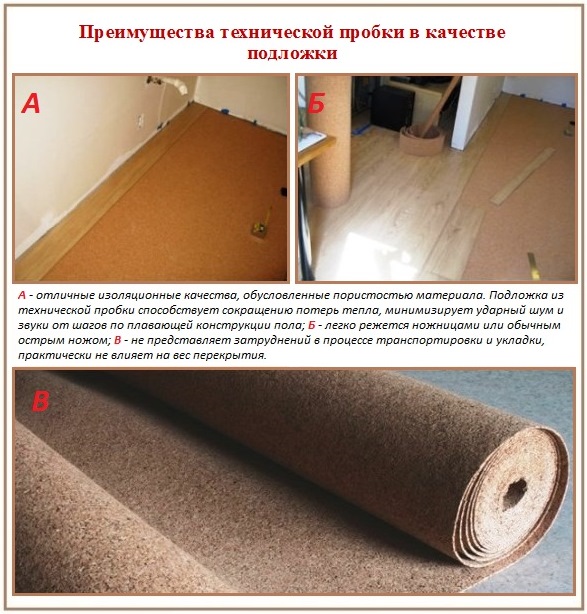
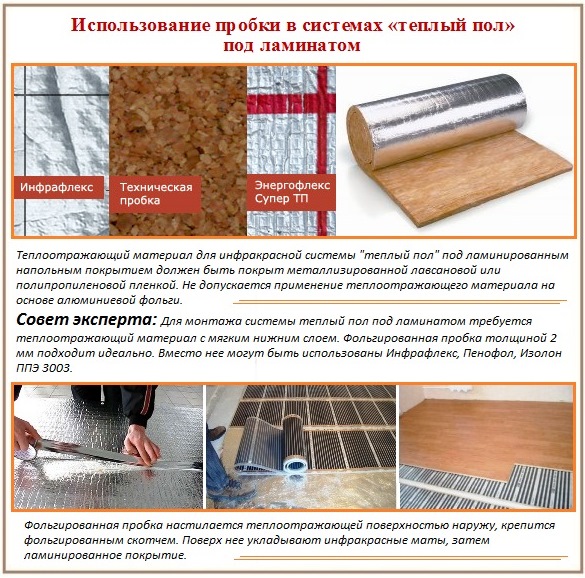
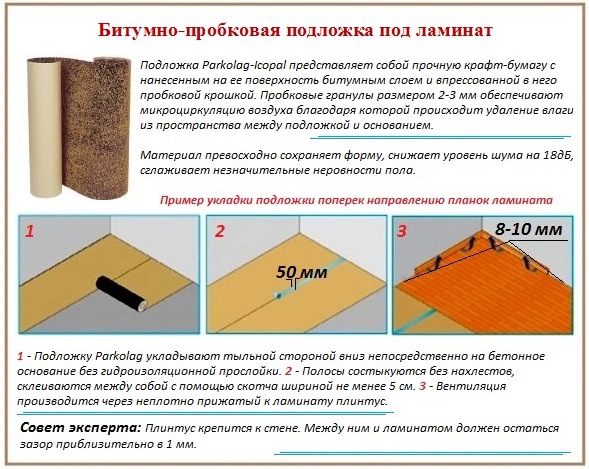
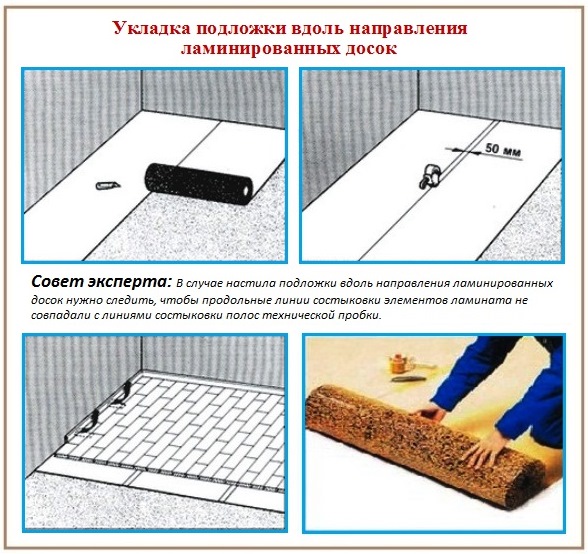

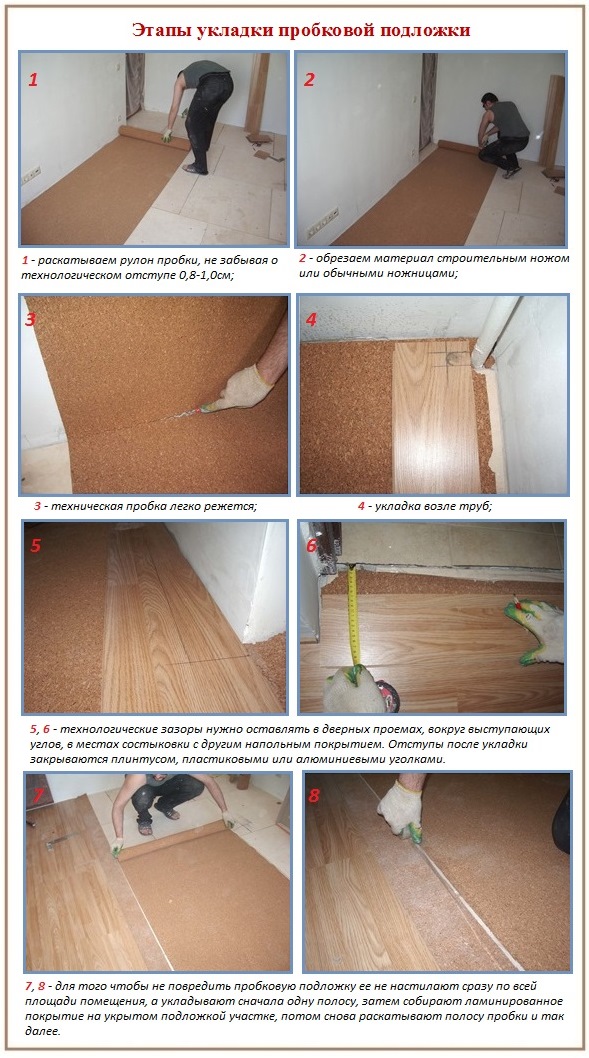
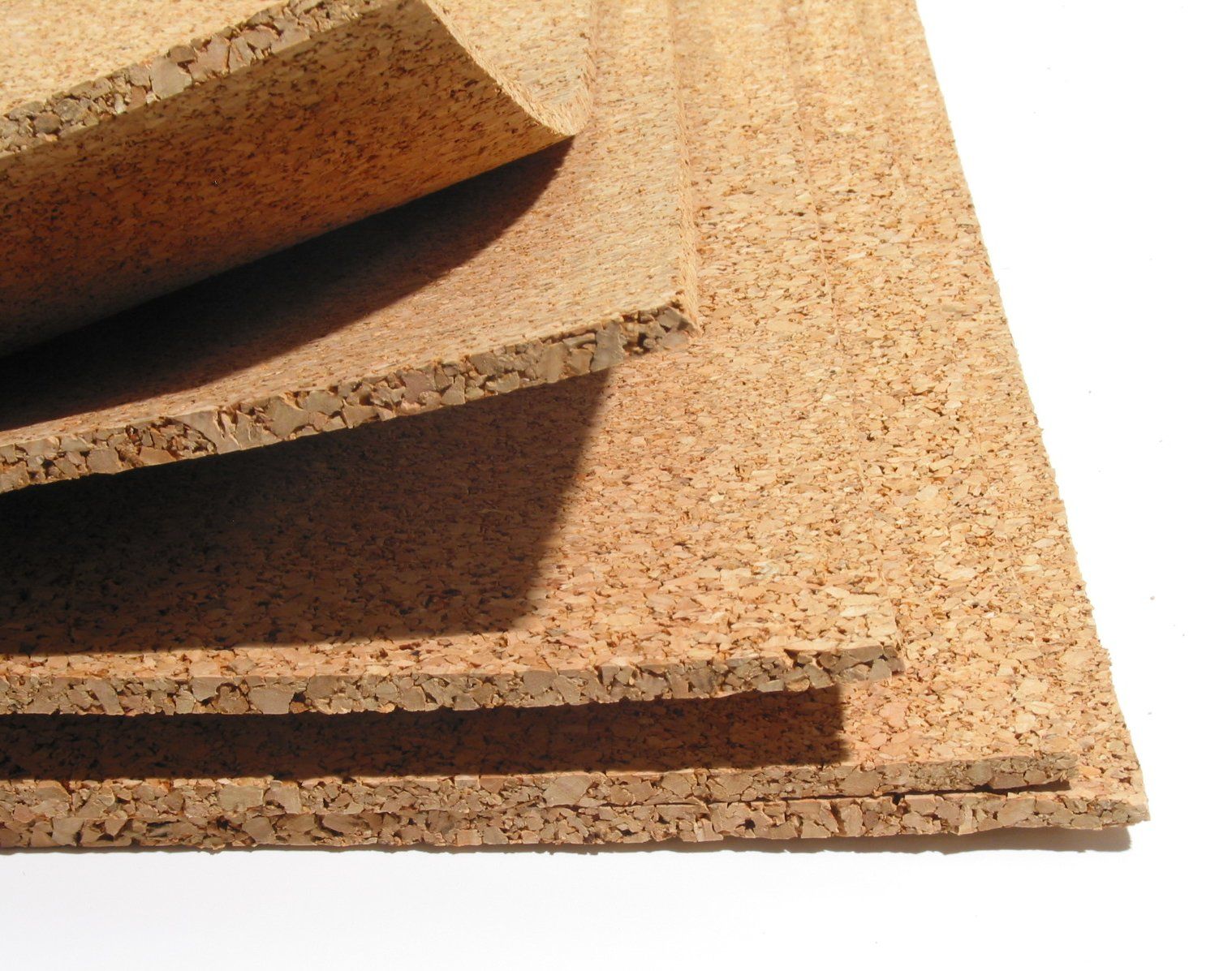
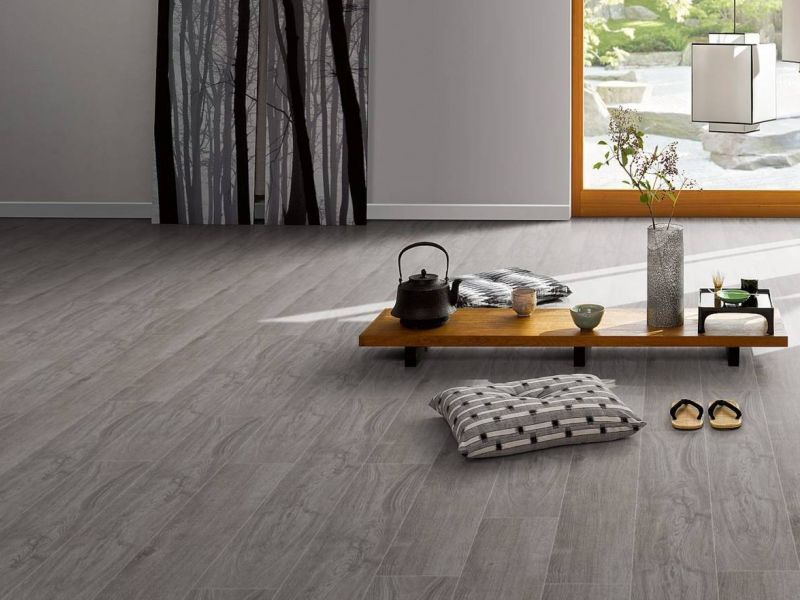
11 comments